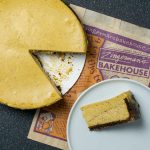Excerpt from Ari’s Top 5 enews
America’s secret fruit shows up on the Southside
It was nearly twenty years ago that we started this project to make Paw Paw Gelato at the Creamery. At the time, hardly anyone in Ann Arbor knew this old American fruit. Today, I’m happy to say, paw paws are getting more and more popular! I’ve seen them in half a dozen shops around town! And we now have a good number of fans waiting for our annual autumn release of this super tasty gelato! I’m happy for paw paw’s increasing popularity. It’s the kind of traditional, delicious food with a great story that we love to work with.
Once upon a time, paw paws were really popular. Native to North America, they have been known historically by a range of wonderful monikers like prairie banana, Hoosier banana, Indiana banana, poor man’s banana, Quaker delight, and hillbilly mango. Paw Paw, Michigan—the town in which Malinda Russell (featured in Patrick-Earl Barnes’ “Blacks in Culinary” art piece at the Roadhouse) was living when she wrote her A Domestic Cook Book in 1866—is named for the fruit (though there are apparently no paw paw trees in town). These trees are about 10 to 20 feet in height with long, dark green, sort of droopy-eared leaves and the largest edible fruit that grows in North America. They look a bit like a mango, but with pear-green-colored flesh. The fruits are ripe when their skin gets a bit darker and the perfume is more pronounced.
Thanks to the folks at Nash Nurseries in Owosso who grow them, and then to the crew at the Creamery for doing all that work to seed and pulp the fruit so the rest of us can just stick our spoon in and enjoy the fruits of their labor. The flavor? Slightly citrusy, kind of custardy, a bit like passion fruit and cherimoya with a little hint of lime, a touch of vanilla, papaya, and ripe pear. Serious Eats said it’s, “a riot of mango-banana-citrus that’s incongruous with its temperate, deciduous forest origins.” Ask for a taste for sure next time you see us!



